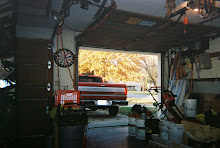If I was made of clay
You could mold me as you please
Then you could rightfully say
I’m the person you want me to be
If my mind was made of circuits
And electronic memory banks
You could rewire me to bid you many thanks
Oct 1, 1974. Kodiak Island (Bering Sea)
willis
Tuesday, April 22, 2008
Wednesday, April 16, 2008
Limerick
NATURE AND THE FINGER
Nature
Impersonal inescapable
Beautiful generous yet unsympathetic
Life
Human’s animals and plants
They live their short time
Here, yet gone in a instant
Their places filled so fast
Scarcely missed
The oceans the mountains
The stars the sky’s seem to last
Yet even they change and die
Their time appears not as abrupt
Geological universal age cosmos
Earthly physical epoch
Death
Everything known and unknown
Born merely to end
Place your finger in a pool of water
Remove it
What is left is entirely what was
Were we ever here
Look into the motionless pool of water
Unchanged unaffected as if untouched
We see we never were
The universe is a larger pool
The finger thus far not removed
We are just insignificant fools
Nature beautiful generous unsympathetic
Infinite immeasurable so vast
Remove the finger and thus heavens existence will not last
willis
Nature
Impersonal inescapable
Beautiful generous yet unsympathetic
Life
Human’s animals and plants
They live their short time
Here, yet gone in a instant
Their places filled so fast
Scarcely missed
The oceans the mountains
The stars the sky’s seem to last
Yet even they change and die
Their time appears not as abrupt
Geological universal age cosmos
Earthly physical epoch
Death
Everything known and unknown
Born merely to end
Place your finger in a pool of water
Remove it
What is left is entirely what was
Were we ever here
Look into the motionless pool of water
Unchanged unaffected as if untouched
We see we never were
The universe is a larger pool
The finger thus far not removed
We are just insignificant fools
Nature beautiful generous unsympathetic
Infinite immeasurable so vast
Remove the finger and thus heavens existence will not last
willis
Friday, April 11, 2008
I don't remember writing this!
I don't remember writing this but found it in my documents?
After thinking and looking, I found this to be part of Charles Hanson Towne works!
(1877-1949)
The days go by and weeks rush on
And before I know it a year is gone
Life is a swift and terrible race
But tomorrow comes and tomorrow goes
And the distance between us grows and grows
And that's what we get and deserve in the end
Around the corner a vanished friend
After thinking and looking, I found this to be part of Charles Hanson Towne works!
(1877-1949)
The days go by and weeks rush on
And before I know it a year is gone
Life is a swift and terrible race
But tomorrow comes and tomorrow goes
And the distance between us grows and grows
And that's what we get and deserve in the end
Around the corner a vanished friend
Friday, March 21, 2008
Space Shuttle Design Feature
Does the statement, "We've always done it like that" ring any bells?
The US standard railroad gauge (distance between the rails) is 4 feet, 8.5 inches.
That's an exceedingly odd number. Why was that gauge used?
Because that's the way they built them in England, and English expatriates built the US Railroads.
Why did the English build them like that?
Because the first rail lines were built by the same people who built the pre-railroad tramways, and that's the gauge they used.
Why did "they" use that gauge then?
Because the people who built the tramways used the same jigs and tools that they used for building wagons, which used that wheel spacing.
Okay! Why did the wagons have that particular odd wheel spacing?
Well, if they tried to use any other spacing, the wagon wheels would break on some of the old, long distance roads in England, because that's the spacing of the wheel ruts.
So who built those old rutted roads?
Imperial Rome built the first long distance roads in Europe (and England) for their legions. The roads have been used ever since.
And the ruts in the roads?
Roman war chariots formed the initial ruts, which everyone else had to match for fear of destroying their wagon wheels. Since the chariots were made for Imperial Rome, they were all alike in the
matter of wheel spacing.
The United States standard railroad gauge of 4 feet, 8.5 inches is derived from the original specifications for an Imperial Roman war chariot. And bureaucracies live forever.
So the next time you are handed a specification and wonder what horse's ass came up with it, you may be exactly right, because the Imperial Roman army chariots were made
just wide enough to accommodate the back ends of two war horses.
Now for the good part .... the twist to the story .....
When you see a Space Shuttle sitting on its launch pad, there are two big booster rockets attached to the sides of the main fuel tank. These are solid rocket boosters, or SRBs.
The SRBs are made by Thiokol at their factory at Utah. The engineers who designed the SRBs would have preferred to make them a bit fatter, but the SRBs had to be shipped by train from the factory to the launch site.
The railroad line from the factory happens to run through a tunnel in the mountains. The SRBs had to fit through that tunnel.
The tunnel is slightly wider than the railroad track, and the railroad track, as you now know, is about as wide as two horses' behinds.
So, a major Space Shuttle design feature of what is arguably the world's most advanced transportation system was determined over two thousand years ago by the width of two horse's ass's.
The US standard railroad gauge (distance between the rails) is 4 feet, 8.5 inches.
That's an exceedingly odd number. Why was that gauge used?
Because that's the way they built them in England, and English expatriates built the US Railroads.
Why did the English build them like that?
Because the first rail lines were built by the same people who built the pre-railroad tramways, and that's the gauge they used.
Why did "they" use that gauge then?
Because the people who built the tramways used the same jigs and tools that they used for building wagons, which used that wheel spacing.
Okay! Why did the wagons have that particular odd wheel spacing?
Well, if they tried to use any other spacing, the wagon wheels would break on some of the old, long distance roads in England, because that's the spacing of the wheel ruts.
So who built those old rutted roads?
Imperial Rome built the first long distance roads in Europe (and England) for their legions. The roads have been used ever since.
And the ruts in the roads?
Roman war chariots formed the initial ruts, which everyone else had to match for fear of destroying their wagon wheels. Since the chariots were made for Imperial Rome, they were all alike in the
matter of wheel spacing.
The United States standard railroad gauge of 4 feet, 8.5 inches is derived from the original specifications for an Imperial Roman war chariot. And bureaucracies live forever.
So the next time you are handed a specification and wonder what horse's ass came up with it, you may be exactly right, because the Imperial Roman army chariots were made
just wide enough to accommodate the back ends of two war horses.
Now for the good part .... the twist to the story .....
When you see a Space Shuttle sitting on its launch pad, there are two big booster rockets attached to the sides of the main fuel tank. These are solid rocket boosters, or SRBs.
The SRBs are made by Thiokol at their factory at Utah. The engineers who designed the SRBs would have preferred to make them a bit fatter, but the SRBs had to be shipped by train from the factory to the launch site.
The railroad line from the factory happens to run through a tunnel in the mountains. The SRBs had to fit through that tunnel.
The tunnel is slightly wider than the railroad track, and the railroad track, as you now know, is about as wide as two horses' behinds.
So, a major Space Shuttle design feature of what is arguably the world's most advanced transportation system was determined over two thousand years ago by the width of two horse's ass's.
Friday, March 7, 2008

What you achieve in your lifetime,
Is directly related to what you do or fail to do.
No one chooses his parents or childhood.
But you can choose you own directions.
Everyone has problems and obstacles to overcome.
But that to is relative to each individual.
Nothing is carved in stone.
You can change anything in your life, if you want to badly enough.
Those who take responsibility for their actions are the real winners in life.
Winners meet life's challenges head on, knowing there are no guarantees,
They give it all they've got, and never think it's too late or too early to begin.
Time plays no favorites, and will pass whether you act or not.
Take control of your life.
Dare to Dream and take risks!
Compete.
Friday, February 29, 2008
My Dad and Me 1959
He came to Lake Dallas Texas and took me fishing on my 5th birthday, Did not see him again for many years after that day. I always liked this picture, as you can tell it's been carried around a lot!
Wednesday, February 27, 2008
Life / Death....Light

As for a man, his days are as grass: as a flower of the field, so he flourisheth.
Life is neither a good nor an evil; it is simply the place where good and evil exist.
Children begin by loving their parents: as they grow older they judge them: sometimes they forgive them.
Father: Carroll..... Feb 2008
Wife/Mother: Rosemary...... Feb 2008
Ask, and it shall be given you: seek, and ye shall find, knock and it will be opened unto you.
.
Subscribe to:
Posts (Atom)









